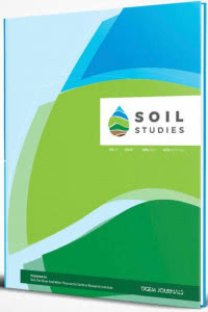Quantification and contribution of nitrogen inputs in the soil on groundwater contamination by nitrates: Valley of High-Cheliff (North Algerian)
Nitrogen (N2) is an essential nutrient for plants. However, when the application of nitrogen exceeds the needs of the plant and the denitrification capacity, nitrogen can migrate to groundwater, usually in the form of nitrates. The transfer of nitrates in soil results from a large number of interdependent factors: climatic, agrological, and agronomic. The Conditions of interaction of these factors can lead to situations more or less favorable to leaching of nitrates. Thus, according to some studies in agronomy, high levels of nitrate pollution observed result from an increase in the mineralization capacity of soils under the cumulative effect of intensive farming practices. Many European countries and some U.S. states are already based on the nitrate test for establishing the optimum nitrogen doses. In agricultural areas, the use of large amounts of mineral fertilizers and the increased volume of animal waste as a result of development of breeding cause nitrogen excess surplus capacity utilization by the vegetation, it is driven into groundwater and causes an increase in nitrate concentrations. With a total annual volume of agricultural production of around 1.5 million tons, agriculture is certainly the pole par excellence of the Hight-Cheliff. The main crops are arboriculture and gardening. Potatoes covered nearly half (48%) of the total volume of agricultural production, it is a major consumer of Nitrogen fertilizers. For the purpose of estimate the amount of leachable nitrogen, nitrogen balance was drawn up , see all the inputs and outputs of nitrogen were almost estimated. This study associate groundwater nitrate pollution with agricultural activity in the high-Cheliff intensive farming regions in Algeria. The spatial probability distribution of nitrate contents, based on nonlinear methods of indicatory kriging, shows the spatial evolution of nitrate through a map established for the year 2011 during high waters. The obtained results show that the areas exceeding nitrate concentrations of 50ppm, occupy more than 80% of the aquifer area, it appears, from this map, the most affected areas are those for with the level of intensification of nitrogen fertilization is strongest specially in the zone of potatoes crops. These results are coherent with the experimental data, which show an average nitrate concentration value of 75ppm, significantly higher than the WHO'S maximum contaminant level. In this study the estimate of the total nitrogen inputs to soils of the valley was 247Kg.ha-1 for this year and compared it with the results of Computer models such as PILOTEN used to analyze alternative management practices together with soil, plant, and climate characteristics to determine nitrogen leached under the potatoes crops ( hot spot areas ).The result show that 60% of nitrogen input is leaching under potato crops which coherent with the spatial evolution of nitrate.
Quantification and contribution of nitrogen inputs in the soil on groundwater contamination by nitrates: Valley of High-Cheliff (North Algerian)
Nitrogen (N2) is an essential nutrient for plants. However, when the application of nitrogen exceeds the needs of the plant and the denitrification capacity, nitrogen can migrate to groundwater, usually in the form of nitrates. The transfer of nitrates in soil results from a large number of interdependent factors: climatic, agrological, and agronomic. The Conditions of interaction of these factors can lead to situations more or less favorable to leaching of nitrates. Thus, according to some studies in agronomy, high levels of nitrate pollution observed result from an increase in the mineralization capacity of soils under the cumulative effect of intensive farming practices. Many European countries and some U.S. states are already based on the nitrate test for establishing the optimum nitrogen doses. In agricultural areas, the use of large amounts of mineral fertilizers and the increased volume of animal waste as a result of development of breeding cause nitrogen excess surplus capacity utilization by the vegetation, it is driven into groundwater and causes an increase in nitrate concentrations. With a total annual volume of agricultural production of around 1.5 million tons, agriculture is certainly the pole par excellence of the Hight-Cheliff. The main crops are arboriculture and gardening. Potatoes covered nearly half (48%) of the total volume of agricultural production, it is a major consumer of Nitrogen fertilizers. For the purpose of estimate the amount of leachable nitrogen, nitrogen balance was drawn up , see all the inputs and outputs of nitrogen were almost estimated. This study associate groundwater nitrate pollution with agricultural activity in the high-Cheliff intensive farming regions in Algeria. The spatial probability distribution of nitrate contents, based on nonlinear methods of indicatory kriging, shows the spatial evolution of nitrate through a map established for the year 2011 during high waters. The obtained results show that the areas exceeding nitrate concentrations of 50ppm, occupy more than 80% of the aquifer area, it appears, from this map, the most affected areas are those for with the level of intensification of nitrogen fertilization is strongest specially in the zone of potatoes crops. These results are coherent with the experimental data, which show an average nitrate concentration value of 75ppm, significantly higher than the WHO'S maximum contaminant level. In this study the estimate of the total nitrogen inputs to soils of the valley was 247Kg.ha-1 for this year and compared it with the results of Computer models such as PILOTEN used to analyze alternative management practices together with soil, plant, and climate characteristics to determine nitrogen leached under the potatoes crops ( hot spot areas ).The result show that 60% of nitrogen input is leaching under potato crops which coherent with the spatial evolution of nitrate.
